|
home
plays
biography
best scene
shop
forum
hot news
photos
much more
- films
- in-depth
- books
-
articles
- glossary
- links
- more links
- search
- site map
- contact
- cold news
all the sites |
Scroll down and click on images for links on the plays.
For links to interviews,
related links, South African history etc click here. |
|
 |
Nongogo
Sheila Fugard
Twentieth Century Literature, Winter 1993
By
the time Athol was writing his next play,
Nongogo, he needed other influences. He had found
a new inspiration in Tone Brulin, a Belgian
theatre director, brought out to South Africa by
the National Theatre. Tone was both a director
and playwright. Athol sat in on his rehearsals
and got a feel for European theatre. This
experience broadened his outlook and gave him
more confidence in himself. Tone sensed Athol's
unique talent. There were township visits with
him, and later we went to Brussels, where Tone
was helpful in getting Athol work in Dutch
theatre.
|
| |
The Blood
Knot
updated as
Blood Knot by 1987 (for links see 1987 version).
|
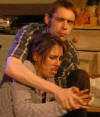 |
Hello and
Goodbye Sam
Thielman Curtain Up
This is a play
about decay, after all, and the ugly mid-century
décor is perfectly realized by Sean Doyle's set
and Nina Mahi Zardonzny's costume design. The
production flags somewhat during the longer
monologues, especially those delivered by
Carroll, whose awkward demeanor works better as a
foil for Novack's brashness. Still, Fugard's
morbid spectacle of a dying family unit is a rare
and challenging one, and the undertaking is
ultimately worth the effort.
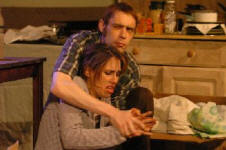
C. Carroll and K. Novack, Photo: John
Mulcahy
|
 |
The Coat
Dennis Walder
Twentieth Century Literature, Winter 1993
It
was a year before the result became visible, in
The Coat, "An Acting Exercise" which
was presented to its first audience, a white Port
Elizabeth "theatre appreciation" group
who, having asked to see a sample of their work,
were expecting a comedy, Wole Soyinka's Brother
Jero. But since the Native Commissioner would
permit performance in a "white area"
only on condition the black performers did not
use the toilets, and returned to the township
after the show, the Players (after bitter debate)
decided to do a reading of The Coat instead,
using pseudonyms from their earlier roles to
avoid trouble with the police, and a Brechtian
actor-presenter who encouraged their white
audience to think about, not merely sympathize
with, what they were witnessing. Fugard's aim was
to "shatter white complacency and its
conspiracy of silence"; for the group, going
ahead was an act of "solidarity," a
testimony to their work together over the years.
The collaborative procedure, with Fugard as
"scribe" and provocateur, and the
performers drawing on their knowledge of New
Brighton, was fully vindicated by the result,
which left their audience of one hundred and
fifty frozen in "horror and
fascination" (Notebooks 142-43) at being
taken out of their safe white world into township
oppression. As "Lavrenti" (Mulligan
Mbikwane) announces in the opening address: 'We
want to use the theatre. For what?... Some of us
say to understand the world we live in, but we
also boast a few idealists who think that Theatre
might have something to do with changing it
(Township Plays 123).
|
 |
People are
living there
(link has gone) performance
review
As Fugard's intellectual mouthpiece, it is the
character Don who has to conceptualise the
issues, making him a problematic and difficult
character to play.
|
 |
The Road to
Mecca Janet Ruth
Twentieth Century Literature, Winter 1993
it
is unusual to find a man exploring the
complexities of women's relationships, which is
precisely what Athol Fugard does in The Road to
Mecca (first performed in 1984 at the Yale
Repertory Theater). He uses the dose friendship
between Helen and Elsa to explore many issues,
especially the isolation of the artist and other
rebels and the ability of an artist to nurture
younger friends. These universal themes enable
the play to transcend mere character studies and
to articulate the deepest needs of both men and
women.
|
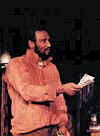 |
Blood Knot (link has gone) Graham has
decided, instead, to focus on the physical
realities of the text, revealing its incredibly
detailed set of rituals and its almost
sado-masochistic inner structure. Returning to a
primitive desire to explain the realities
confronting two impoverished men in one room, he
has built from there.
|
 |
Blood Knot intervals
marked by a wind-up alarm clock (a device that
Fugard shamelessly borrows from Jean Genet's The
Maids).
|
 |
Blood Knot (link has gone) Far too
often Fugard’s earlier works - being
budget-friendly and politically motivated - are
tackled by amateur or student theatre groups; and
far too often the play’s message and its
political lesson is lifted out and prioritised.
|
 |
Blood Knot Mary Benson
Twentieth Century Literature, Winter 1993
"A
play that never ended," is Athol Fugard's
recollection, in a conversation with me in 1986,
of the first performance of The Blood Knot: it
went on for four hours "on a terrible little
stage, only about six inches high at one
end." The momentous event took place in
Johannesburg in 1961 with Fugard and Zakes Mokae
playing Morrie and Zach. The tiny rehearsal room
of the African Music and Drama school in Dorkay
House, a rundown factory in the automobile
district, was packed on that suffocating summer's
evening. Egg boxes were glued to one wall to shut
out the noise of traffic, but through blacked-out
windows on the opposite side came the beat of
drums from a nearby mine compound.
|
 |
Blood Knot Le lien du sang (Blood
Knot in French)
Sud-Africain blanc, Athol
Fugard est un auteur joué dans le monde entier.
Ses plus récentes pièces écrites en
collaboration avec des écrivains noirs ont
intéressé Peter Brook, et bien d'autres. Mais,
en France, l'heure de la gloire n'a pas sonné
pour lui... La création du Lien du sang pourrait
aider à le mieux connaître, car elle nous
montre que Fugard n'a pas cette raideur, cette
netteté anglo-saxonne qu'on lui attribuait
volontiers, mais un art très complexe de
traduire la réalité.
|
 |
A Place with
the Pigs Gerald Weales
Twentieth Century Literature, Winter 1993
If
The Guest is the only Fugard work to make an
obvious allusion to his alcoholism, A Place with
the Pigs is the only one to celebrate his drying
out. Pavel begins the play with the hope- even
the expectation- that he will be able to leave
the pigsty in which he has been hiding, but when
this proves impossible and when the excitement of
a momentary walk outside ends with his hurrying
back into his sanctuary/cage, he declines from
the relative fastidiousness of the first scene to
complete the filthy identification with the pigs.
It is only after his wife has beaten him back
into his manhood that he is able to release the
pigs, and he and Praskovya can leave the sty.
|
 |
My Children!
My Africa!
(link has gone) At the
heart of the play is a paradox. Mr M passionately
needs to be a teacher. But he can only be a
teacher if he obeys South African laws and offers
a Bantu education. Ironically the Bantu education
he offers leads Thami to reject him in and his
school.
The play is both a cry
for tolerance and a bitter acceptance of the
violence that flares to destroy peace in South
Africa. It is not possible to ignore the parallel
between Mr. M., and his search for change through
peaceful and intelligent intervention, and
another Mr. M., now President Nelson Mandela.
|
 |
My Children!
My Africa!
Nicholas Visser
Twentieth Century Literature, Winter 1993
Newspaper
articles and reviews in Johannesburg and Gape
Town published to coincide with the opening of
the play in the two cities describe how Fugard
found the initial germ of the play in a newspaper
article describing the death of a teacher in the
Eastern Gape town of Cookhouse in 1984 (actually,
of course, 1985). Finding out more about the
incident has not been easy. It is not mentioned
in the Race Relations Survey, nor was it reported
in major newspapers outside the Eastern Cape.
Until recently it was, understandably, difficult
to find anyone in either opposition or government
circles prepared to speak freely about what took
place. As far as it is currently possible to
reconstruct the incident, what took place was
this. On Tuesday, 30 April 1985, Anela Myalatya
(Fugard oddly retains his actual name), a
twenty-nine-year-old teacher of junior secondary
school pupils (not, as in the play, an elderly
teacher of senior pupils) at Msodomvu
Intermediate School in Cookhouse became caught up
in the political turmoil of the Eastern Cape.
Early in the day he acted as an interpreter at a
meeting at which the circuit inspector
responsible for African schools in the area
addressed teachers, parents, and pupils about the
need, as he saw it, to "normalize" the
school. Later in the day Myalatya requested
permission to be absent from school the following
day. He had learned that because of an incident
that had taken place the previous week he might
be in some danger.
|
 |
Playland Philip Fisher
British Theatre Guide
This piece is a
little slight and on occasions the sentiments can
seem a little trite but even so the subject
matter is very important and remains so as
cultural differences are still apparent in South
Africa and Zimbabwe today. With good performances
from both Samson Khumalo and Mark Wakeling, this
thought provoking play is one that anyone
interested in politics and the issue of race
should see.
|
 |
Playland Mary Benson
Twentieth Century Literature, Winter 1993
The
play's gestation began in December 1966 when
Fugard took his small daughter Lisa to Playland,
an amusement fair traveling the Karoo. He watched
the attendant of the "happiness
machines," an African in faded overalls,
behaving oddly, "muttering darkly to
himself," his eyes with an "abstracted
intensity" (Notebooks 145). That man is now
incarnated in the character of Martinus. The
catalyst for Fugard in writing the play was a
photograph of white South African soldiers
dropping the corpses of black men into a crude
hole. In the play a black woman stands,
watching--a sorrowful mother?--an image inspired
by Pergolesi's Stabat Mater.
|
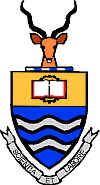 |
My Life (link has gone) The vision
it offers of young people struggling to come to
grips with their personal growth and development
in a country which is itself struggling to cope
with fundamental change is warm, funny,
disturbing and, occasionally, inspirational.
|
 |
A Valley Song The old men,
he says, represent winter wisdom, the young girl
spring dreams.
|
 |
A Valley Song As an actor,
Fugard is as straightforward, skilled and
likeable as he is as a writer.
|
| Valley Song |
A Valley Song the play may
be too small, too simple, too obvious in its
human drama, its poetry, its elegiac tone and its
wistful politics. But such is the play. And
that's just fine.
|
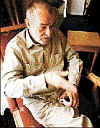 |
The Captain's
Tiger
(link has gone) interview
I took to theatre like a fish to water. I
discovered that I was fascinated in particular
with language in the way it lives in the spoken
word, what happens with it in people's mouths.
|
 |
The Captain's
Tiger
The
Captain's Tiger is woefully underwritten: it
lacks interesting conflict, it suffers from
anaemic character relationships, and the dramatic
punch line is telegraphed from the start.
|
 |
The Captain's
Tiger
Fugard plays
himself brilliantly. He is without question the
best actor on the stage at all times, carrying
the play with his ability to create a truly
engaging character. Beginning with his opening
soliloquy, Fugard captures the audience with his
incredible, musical diction and energetic
mobility.
|
 |
The Captain's
Tiger
(link has gone) interview
by Charles Fourie
[Tolstoy] was my great hero in my reading youth,
and he still is. I've just finished reading Anna
Karenina again...
Dialogue is
iceberg territory where you see very little above
the water of the real mass that is hidden
beneath.
|
 |
The Captain's
Tiger
(link has gone) That there
is doubt indicates that this play is far less
didactic than many of Fugard's previous works,
some of which, in performance and text, placed
the intellectual before the theatrical. Despite
this text's intensely personal nature, where the
other characters are foils for Fugard's journey,
it rarely allows for audience identification or
empathy, promoting a sense of indifferent
detachment....
Perhaps the
production would have been more effective and
certainly more varied if the young Fugard was
played by a young actor, thereby at least
releasing the older, "narrative" Fugard
from performing his own recollections.
|
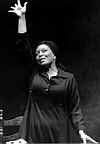 |
Sorrows and
Rejoicings (link has gone) In Sorrows
and Rejoicing Athol Fugard has written an
opera without music. Characters talk to the
audience much of the time, in lengthy, repetitive
arias. They very seldom talk to each
other....Some Americans gave it a standing
ovation. But I think they were applauding the end
of apartheid. Not a good play.
|

|
Sorrows and
Rejoicings Marianne
McDonald

This play is about the
personal journey of everyone in it. There are
five main personal relationships: Marta/Dawid,
Allison/Dawid, Dawid/Rebecca, Allison/Marta, and
Marta and Rebecca. Dawid is dead, so those
relationships are over, even though they still
influence the lives of all he touched. The last
two relationships are ongoing, significant not
only for the people involved, but symbolically
for the future of South Africa. In these
relationships there is hope. Allison and Marta
made a journey from conflict to reconciliation,
as Marta says, "Life is full of surprises,
hey Allison".
|
 |
Sorrows and
Rejoicings (link has gone) "Sorrows
and Rejoicings," above all, is about
reconciliation: between Marta and Allison,
between Dawid and his illegitimate child by
Marta, Rebecca and finally between the
"new" South Africa and the
"old," apartheid-era South Africa.
Because none of these reconciliations quite
succeed, however, the audience cannot help but
leave the theater feeling as helpless as the
spectators in Dawid's ruin.
|
| 2ST |
Sorrows and
Rejoicings (link has gone) 2ST, Dr.
Marianne McDonald
"This
is the first play written in its entirety outside
of South Africa, and it shows the profound
longing of a man for the land of his birth and
his mother tongue. It is a play about someone who
has left South Africa, and who misses his country
every day"
|
 |
Sorrows and
Rejoicings TheatreMania.com, David
Finkle
As the confrontations in Sorrows
and Rejoicing come one after another, the
suffering that the end of apartheid and its
have inflicted on the various populations of
South Africa is made increasingly plain. As
Fugard depicts them, the accumulated feelings
come to possess the burning intensity of a flame.
But another revelation about Fugard’s
compulsive vision comes into focus as well, and
it takes the edge off his accomplishment:
He’s too schematic. The Sorrows and
Rejoicing symbols proliferate until they almost topple the
play: The living room in which the afflicted country’s peoples
are so carefully represented is too patently a metaphor for
South Africa.
|
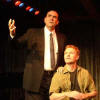 |
Exits and
Entrances Karen Weinstein
Los Angeles 1 Jun 2004
It is not often
that a new work by an acclaimed playwright opens
in a very small theater. Exits and Entrances not
only debuted at the 78 seat Fountain Theater on
the east side of Hollywood, it was expressly
written for this venue. It is by Athol
Fugard’s own description, “a small
play,” and is satisfying only if viewed in
this light. He sees himself as being “a
miniaturist (who) writes on small canvases.”
A one act, written for two characters, and
lasting less than 90 minutes including extensive
excerpts from classic theater, Exits and
Entrances is a vignette or a showcase, rather
than a fully developed play...
So what is missing? Exits and Entrances is
tightly written and very quotable, skillfully
acted and directed. Yet something is lacking.
With all that finesse, audience emotion is not
engaged. Huguenet’s acting competence is
established repeatedly with Hurley reciting
complete passages from classic works such as the
entire soliloquy from Hamlet. But the pain and
loneliness of a closeted homosexual in an
intolerant society, or a confirmed Afrikaner in a
world that is passing him by, is not explored.
Might it not be better to devote less stage time
to the established genius of Shakespeare and more
to the inner life of the characters? Was the
young playwright always so charming and gracious?
Could he be as enveloped in the politics of his
country as he is and yet always present such a
pleasant face? This is autobiography without
revelation--well done and pleasant to watch, but
it could have been so much more.
|
 |
Exits and
Entrances Sharon
Perlmutter, talkingbroadway.com
In
Huguenet, Fugard has written a true tour de force
role, and Morlan Higgins makes the most of it.
Whether he is putting on makeup, running through
his lines, having a prima donna moment, or kindly
sharing a word about his life in the theatre with
the playwright who clearly idealizes him, Higgins
is mesmerizing. (Indeed, perhaps the greatest
feature of William Dennis Hurley's performance as
the playwright is his ability to disappear even
though he's still on stage.) In its short
80-minute running time, Exits and Entrances gives
an actor the opportunity to play Sophocles and
Shakespeare as well as Fugard, and Higgins
doesn't waste it. While running lines in
preparation to take the stage as Oedipus,
Huguenet slides into character, giving a taste of
a powerful, chill-inducing performance. But
Higgins also plays the moments Fugard has
written, making a speech about where an actor's
"home" is truly poignant even though we
all know the place he is going to name.
|
 |
Exits and
Entrances Judy van der
Walt Tonight 25 May 2004
Almost 90 years ago in a theatre in Bloemfontein,
a Russian ballerina lit a creative spark in an
11-year old Afrikaans boy who would one day be
recognised as a visionary in South African
theatre.
Many years later, the boy, André Huguenet,
became a mentor to Athol Fugard, who was named
the greatest active playwright in the
English-speaking world by Time magazine in 1989
and whose plays are produced with a frequency
second only to The Bard.
Now 71, Fugard tells Judy van der Walt why his
latest play is an 'an expression of gratitude I
must make before I climb into my coffin a
reasonably contented man...'
The autobiographical Exits and Entrances is about
the playwright's relationship with Huguenet, who
gave him his first job as an actor, casting him
as the shepherd who clings desperately to the
ankles of Huguenet's Oedipus.
"André was very important to me in terms of
my awareness of theatre. The fact that he was a
visionary might well have been the provocation
that I needed to formulate a vision of my
own," Fugard says.
|
 |
Karoo Michiel Heyns
Sunday Independent, 10 July 2005
The problem may be that in fleshing out his
characters Fugard does not imagine them from the
inside out; he imposes attitudes upon them.
Bluntly put, these are location dwellers not as
they might have experienced their own existence,
but as Fugard wanted to see them. |
|